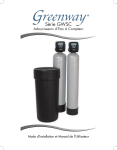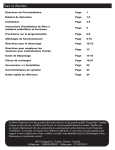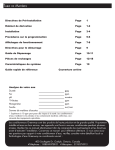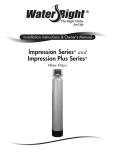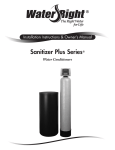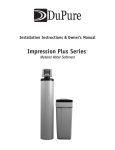Download Avid Water Systems AFS Series Owner`s manual
Transcript
Installation Instructions and Owner’s Manual AFS Series Iron Filter / Softener System Avid Water Systems 12630 US Highway 33 N Churubusco, IN 46723 Phone (260) 693-1972 Fax (260) 693-0602 www.avidwatersystems.com AFS Instruction Manual 020312.docx This page intentionally left blank. 1 Preinstallation Instructions Description of the iron filter / softener system The AFS system includes a filtration tank, softener tank, brine tank, and a backwashing control valve. Incoming water flows into the control valve and is directed into the filtration tank. Exposure to the air in this tank will start oxidizing the iron and the filtration media will trap this iron. The water then flows through the back connector tube and into the softener tank where the water is then softened. The iron-free softened water then returns to the control valve where it is directed into the service lines. Periodically the control valve will go through a backwash cycle. This cycle will typically begin at 2:00 A.M. flushing the accumulated iron and hard elements to the drain. Part of this backwashing process includes an air draw cycle which will replenish the pocket of air in the filtration tank and a brining cycle which recharges the softening resin in the softener tank. After the backwashing process the unit is now prepared for the next period of service. Water Quality While the AFS filter/softener will perform under a variety of water qualities there are a few things that need to be considered to ensure satisfactory performance. The water should be tested to determine the concentration, or levels of the items listed below. pH - A measurement of the acidity of the water. pH is reported on a scale from 0 to 14. Neutral water has a pH of 7.0, lower values indicate acidic water. The AFS performs best when the pH is 7.0, or higher. pH values below 7.0 require a special media blend in the filter in order to elevate the pH for proper iron oxidation. Iron - A naturally occurring metallic element. Iron concentrations in excess of 0.3 milligrams/liter (mg/l) combine with oxygen causing orange or red (rust) stains on plumbing fixtures. Iron naturally exists in some water sources in either clear water (ferrous) state, red water (ferric) state or bacterial form. The AFS iron filter portion can reduce any of these forms of iron. Manganese - A naturally occurring metallic element. Manganese concentrations as low as 0.05 milligrams/liter (mg/l) can combine with oxygen to cause dark brown or black staining on fixtures. Additionally, manganese can cause an odor in the water similar to a “rotten egg” smell. The AFS reduces manganese as well as iron, however, manganese oxidation requires the pH of the water to be elevated to 8.2 or higher. Special media might need to be added to elevate the pH of manganese bearing waters. Tannin - A naturally occurring humic acid. Tannin is an acid caused by water passing through decaying vegetation. Coffee and Tea are prime examples of tannin in water. As hot water passes over the coffee beans, or tea leaves, the tannin is extracted causing color and flavor in the water. Tannin concentrations as low as 0.3 milligrams per liter can cause a yellow discoloration in the water and may interfere with the AFS’s long-term ability to remove the iron as the media becomes coated with the tannic acid. Hydrogen Sulfide - A naturally occurring gas. Hydrogen sulfide, more commonly referred to as sulfur gas, causes a distinct odor similar to “rotten eggs.” Due to its gaseous nature, hydrogen sulfide must be tested at the well site within 1 minute of drawing the sample. If a water sample has been sitting for a while the sulfur gas will dissipate and cause the hydrogen sulfide test to be lower than the actual concentration. If sulfur is present, the filter should be set to backwash more frequently to prevent the gas from building up. The AFS can typically treat up to 1 to 2 milligrams per liter of sulfur gas. 2 Water Supply Unlike other iron filters that do not use chemicals to oxidize the iron, the AFS iron filter portion does not require additional plumbing such as solenoid valves, pressure switches or pressure tanks. This filter will function properly when the water supply is furnished by a jet pump, submersible pump, variable speed (constant pressure) pump or community water supply. As with all other filter systems, however, it is imperative that the well pump provides enough flow rate for the filter to adequately backwash. In order to ensure sufficient backwash flow rate the following pumping rate test should be performed prior to installing the AFS. 1. Make certain no water is being drawn in the house. 2. Open spigot nearest pressure tank. 3. When well pump starts, close spigot and measure time (in seconds) to refill pressure tank (well pump turns back off). This is Cycle Time. 4. Using a container of known volume, draw water from pressure tank and measure how many gallons until the pump turns back on again. This is Draw Down. 5. Calculate pumping rate by dividing draw down by cycle time and multiplying by 60. Draw Down (gallons) Cycle Time (seconds) Example: 8 gallons 65 seconds X 60 = Pumping Rate (gallons per minute) Draw down is 8 gallons Cycle time is 65 seconds X 60 = 7.4 gpm (gallons per minute) Location Considerations The proper location to install the AFS will ensure optimum filter performance and satisfactory water quality. The following factors should be considered in selecting the location of this system. 1. The system should be installed after the pressure tank (private well system only). 2. The system should be installed as close as possible (preferably within 15’) to an adequate floor or laundry drain capable of handling the backwash cycle volume and flow rate (refer to unit specifications). 3. All water conditioning equipment should be installed prior to the water heater. Water temperatures exceeding 100°F can damage the internal components of the control valve and filter tank. 4. The system should not be subject to freezing temperatures. 5. Never install a cartridge type filter prior to the AFS. Any cartridge or in-line filter (if desired) should be installed after the AFS system. This will prevent restricting the water flow and pressure available for backwash. 6. Appliances requiring extended periods of continuous or high flow water use (i.e. geothermal heat pumps, swimming pools, lawn irrigation, outside hose bibs, etc.) should bypass the filter and a spring check valve should be installed on the AFS inlet to prevent backflow from the filter (see installation diagram Fig. 1). 7. An expansion tank may need to be installed in the line to the water heater in order to allow for thermal expansion and comply with local plumbing codes. 3 Preinstallation Instructions Cont. The manufacturer has set the water treatment unit’s sequence of cycles, cycle times, salt dose, exchange capacity and gallon capacity. The salt dose refill time has been preset. The dealer should read this page and guide the installer regarding hardness, day override, and time of regeneration, before installation: For the installer, the following must be used: Set Installer Settings… Hardness (preset to 20 gpg), Day Override (preset to 3 days), and Time of Regeneration (preset to 2 am). Read Normal Operating Displays Set Time of Day Read Power Loss & Error Display Water Softeners: During operation, the normal user displays are time of day, gallons per minute or gallons remaining before regeneration will occur. Days remaining is an optional display but is not normally used on metered softeners. Each of these can be viewed by pressing NEXT to scroll through them. When stepping through any displays or programmings, if no buttons are pressed within 5 minutes, the display returns to a normal user display. Any changes made prior to the 5 minute time out are incorporated. If desired, two regenerations within 24 hours are possible with a return to the preset program. To do a double regeneration: 1. Press the REGEN button once, REGEN TODAY will flash on the display. 2. Press and hold the REGEN button for three seconds until a regeneration begins. Once the valve has completed the immediate regeneration, the valve will regenerate one more time at the preset time. BYPASS VALVE: The bypass valve is typically used to isolate the control valve from the plumbing system’s water pressure in order to perform control valve repairs or maintenance. The 1” full flow bypass valve incorporates four positions including a diagnostic position that allows a service technician to have pressure to test a system while providing untreated bypass water to the building. Be sure to install bypass valve onto main control valve, before beginning plumbing or make provisions in the plumbing system for a bypass. © The bypass body and rotors are glass filled Noryl and the nuts and caps are glass filled polypropylene. All seals are self-lubricating EPDM to help prevent valve seizing after long periods of non-use. Internal “O” Rings can easily be replaced if service is required. The bypass consists of two interchangeable plug valves that are operated independently by red arrow shaped handles. The handles identify the direction of flow. The plug valves enable the bypass valve to operate in four positions. 4 1. Normal Operation Position: The inlet and outlet handles point in the direction of flow indicated by the engraved arrows on the control valve. Water flows through the control valve for normal operation of a water softener or filter. During the regeneration cycle this position provides regeneration water to the unit, while also providing untreated water to the distribution system. (Fig. 1) 2. Bypass Position: The inlet and outlet handles point to the center of the bypass. The system is isolated from the water pressure in the plumbing system. Untreated water is supplied to the building. (Fig 2) 3. Diagnostic Position: The inlet handle points toward the control valve and the outlet handle points to the center of bypass valve. Untreated supply water is allowed to flow to the system and to the building, while not allowing water to exit from the system to the building. (Fig. 3) This allows the service technician to draw brine and perform other tests without the test water going to the building. NOTE: The system must be rinsed before returning the bypass valve to the normal position. 4. Shut Off Position: The inlet handle points to the center of the bypass valve and the outlet handle points away from the control valve. The water is shut off to the building. The water treatment system will depressurize upon opening a tap in the building. A negative pressure in the building combined with the softener being in regeneration could cause a siphoning of brine into the building. If water is available on the outlet side of the softener it is an indication of water bypassing the system (Fig. 4) (i.e. a plumbing cross-connection somewhere in the building). 5 INSTALLATION: GENERAL INSTALLATION & SERVICE WARNINGS The control valve, fittings and/or bypass are designed to accommodate minor plumbing misalignments. There is a small amount of “give” to properly connect the piping but the water softener is not designed to support the weight of plumbing. Do not use Vaseline, oils, other hydrocarbon lubricants or spray silicone anywhere. A silicone lubricant may be used on black “O” Rings. This will allow ease of installation and decrease chance of rolling from the bypass and tank connections. Avoid any type of lubricants, including silicone, on red or clear lip seals. ® Do not use pipe dope or other sealants on threads. Teflon tape must be used on the threads of the 1” NPT ® inlet and outlet and on the threads for the drain line connection. Teflon tape is not used on the nut connections or caps because “O” Ring seals are used. The nuts and caps are designed to be unscrewed or tightened by hand or with the special plastic Service Wrench, part # CV3193. If necessary pliers can be used o unscrew the nut or cap. Do not use a pipe wrench to tighten nuts or caps. Do not place screwdriver in slots on caps and/or tap with a hammer. SITE REQUIREMENTS Water pressure – 25-100 psi o o Water temperature – 33-100 F (0.5-37.7 C) Electrical – 115/120 V, 60 Hz uninterrupted outlet The tank should be on a firm level surface Current draw is 0.5 amps The plug-in transformer is for dry locations only Spring Check Valve Cold softened/filtered water Hot softened/filtered water Untreated Water for geothermal heat pumps, swimming pools, lawn irrigation, hose bibs etc. Water Heater Untreated Water AFS System FIGURE 1: Typical Installation 6 Installation Instructions STEP 1: If media is already loaded in filter tank proceed to Step 4. Otherwise, use the fillport wrench provided to remove the fillport cap (Refer to Figure 2) by turning it counter-clockwise. STEP 2: DO NOT REMOVE THE WHITE FILLPORT SCREEN! Use the fill funnel provided and add the required amount of media (see unit specifications) to the filter tank. Do not overfill the tank. At least 14” of freeboard (empty space) is required at the top of the media tank to allow for proper bed expansion during backwash. Any excess media may be saved for future replenishment. STEP 3: Clean any media out of the fillport cap threads. Do not reinstall the fillport cap until Step 9. STEP 4: Place softener tank on right side with inlet/outlet facing left. Place filter tank on left with inlet/outlet facing right. Fillport Cap Filter Tank Softener Tank FIGURE 2: Tank Positioning and Fillport Location STEP 5: Attach the control valve assembly to the front inlet opening of the filter tank and outlet opening of the softener tank. Attach the straight pipe adapter to the back outlet of the filter tank and inlet of the softener tank. HAND TIGHTEN UNION NUTS ONLY. DO NOT OVERTIGHTEN. 7 Outlet to service Inlet from water supply STEP 6: Shut off water at main supply. Relieve pressure by opening nearest faucet. On private well systems, turn off power to pump and drain pressure tank. SHUT OFF POWER OR FUEL SUPPLY TO WATER HEATER. STEP 7: Cut main supply line as required to fit plumbing to inlet and outlet of bypass valve. DO NOT PLUMB INLET AND OUTLET BACKWARDS. Piping should support control valve in an upright position. Do not apply heat to any fitting attached to the bypass or control valve. STEP 8: Use rigid drain line or polyethylene tubing (NO VINYL TUBING) to run drain line from control valve discharge fitting to floor drain or sump pit capable of handling the backwash rate of the filter (refer to specifications and flow rate on page 8). DISCHARGE END OF THE DRAIN LINE MUST BE FIRMLY SECURED! Failure to properly secure the drain line will result in the drain line “whipping” and possibly flooding the area causing water damage. There must be an air gap at the end of the drain line to prevent siphoning of waste water and meet plumbing code. Total length of drain line should be 15’ or less. AVOID OVERHEAD DRAINS. STEP 9: Use a garden hose or bucket to fill the media tank with water through the fillport. Ensure media has been cleaned from fillport threads and install cap securely with wrench provided. STEP 10: Be sure the control valve is in the “Service” position (refer to programming procedures for instructions). The bypass valve should be in the “Bypass” position (refer to bypass valve for instructions). Open main supply valve or turn on power to pump on private well systems. STEP 11: Open bypass valve ¼ of the way allowing unit to pressurize slowly. It is normal for air to be trapped in the top part of the aeration tank. Once tanks are pressurized, fully open bypass valve to the “Service” position. STEP 12: Set the day override for every third day (refer to programming procedures for instruction). Ensure that the day override is set so that the filter will not backwash for two more days. This will allow the filter media time to saturate with water. Subjecting the filter to backwash flow rates within 24 hours of installation may flush media to the drain. STEP 13: Set the current time of day on the timer (note AM and PM) and set the hardness of the water. STEP 14: Check for leaks and correct as necessary. STEP 15: Turn power or fuel supply back on to water heater. 8 Programming Procedures for the AFS 1. Set Time of Day: Time of day should only need to be set after extended power outages or when daylight saving time begins or ends. If an extended power outage occurs, the time of day will flash on and off indicating that the time should be reset. STEP 1 -- Press SET CLOCK STEP 2 -- Current Time (hour): Set the hour of the day using 12. Press next to go to step 3. or buttons. AM/PM toggles after STEP 3 -- Current Time (minutes): Set the minutes using or buttons. If it is desired to go back up to the previous step press regen button once. Pressing next will exit Set Clock and return to the general operating display. 2. Programming: NOTE: The manufacturer has preset the unit so that the gallons between regenerations will be automatically calculated after the hardness is entered. STEP 1 -- Press next and simultaneously for 3 seconds. STEP 2 -- Hardness: Set the amount of hardness in grains per gallon (default 20) using the buttons. The allowable range is from 1 to 150 in 1 grain increments. or Press next to go to step 3. Press regen if you want to exit. STEP 3 -- Day Override: The manufacturer has factory set this at 3 days as the default. This is the maximum number of days between regenerations. A regeneration initiation will be called for on that day even if a sufficient number of gallons were not used to call for a regeneration. Set the day override using or buttons (3 is recommended). Press next to go to step 4. Press regen if you need to return to the previous step. 9 2. Programming cont’d: STEP 4 -- Regeneration Hour: The manufacturer has factory set 2:00 am as the default. This is the hour of day for regeneration and can be reset by using or buttons. “AM/PM” toggles after 12. The default time is 2:00 a.m. (recommended for a normal household). Press next to go to step 5. Press regen if you need to return to the previous step. STEP 5 -- Regeneration Minutes: Set the minutes using or buttons. Press next to exit Installer Settings. Press regen if you need to return to the previous step. To initiate a manual regeneration immediately, press and hold the regen button for three seconds. The system will begin to regenerate immediately. The control may be manually stepped through the regeneration cycles by pressing regen. 10 Operating Displays for the AFS 1. General Operation: When the system is operating, one of the three displays may be shown. Pressing next will alternate between displays. One of the displays is always the current time of day. The second display shows the current treated water flow rate through the system in Gallons Per Minute (gpm). The third display shows the current volume remaining in Gallons. Capacity remaining is the gallons that will be treated before the system goes through a regeneration cycle. The user can scroll between the displays as desired. If the system has called for a regeneration that will occur at the preset time of regeneration, the words REGEN TODAY will appear on the display. The AFS has an installed water meter, the word “Softening” flashes on the display when water is being treated (i.e. water is flowing though the system). 2. Regeneration Mode: Typically a system is set to regenerate at a time of no water use. If there is a demand for water when the system is regenerating, untreated water will be delivered. When the system begins to regenerate, the display will change to include information about the step of the regeneration process and the time remaining for that step to be completed. The system runs through the steps automatically and will reset itself to provide treated water when the regeneration has been completed. 3. Manual Regeneration: Sometimes there is a need to regenerate before the control valve calls for it. This may be needed if a period of heavy water use is anticipated or when the system has been operated without salt. To initiate a manual regeneration at the preset delayed regeneration time, press and release regen. The words “REGEN TODAY” will flash on the display to indicate that the system will regenerate at the preset delayed regeneration time. If you pressed the regen button in error, pressing the button again will cancel the command. To initiate an immediate manual regeneration, press and hold the regen button for three seconds. The system will begin to regenerate immediately. This command cannot be cancelled. 4. Power Loss: If the power goes out for less than two hours, the system will automatically reset itself. If an extended power outage occurs, the time of day will flash on and off which indicated the time of day should be reset. The system will remember all other settings. Error Message: If the word “ERROR” and a number are alternately flashing on the display, record the number and contract the dealer for help. This indicates that the control valve was not able to function properly. 11 Troubleshooting Guide for the AFS: PROBLEM 1 Timer does not display time of day 2 Timer does not display correct time of day 3 No softening display when water is flowing 4 5 ● ● ● ● ● Unit regenerates at wrong time of day "Error" followed by code # "Error" code 1001unable to recognize start of regeneration "Error" code 1002unexpected stall "Error" code 1003motor ran too long Timed out trying to reach next cycle position If other codes appear contact factory CAUSE A. transformer unplugged B. no power at outlet C. defective transformer D. defective PC board A. outlet is on a switch B. power outage C. defective PC board A. bypass valve in bypass position B. meter cable disconnected CORRECTION A. reconnect transformer B. repair or use working outlet C. replace transformer D. replace PC board A. use unswitched outlet B. reset time of day C. replace PC board A. put bypass in service position B. reconnect to PC board C. remove meter and check for C. restricted/stalled meter turbine debris D. defective meter D. replace meter E. defective PC board E. replace PC board A. past power outage A. reset time of day B. incorrect time of day displayed B. reset time of day C. time of regenerant set incorrectly C. reset time of regeneration D. check with regeneration time D. control set at "on 0" option in programming E. check with regeneration time E. control set at "NORMAL + on 0" option in programming A. press NEXT and REGEN for 3 secs or A. valve has just been serviced momentarily unplug power source from PC board. B. check piston and spacer stack for B. foreign material stuck in valve obstruction C. replace piston(s) and spacer C. excessive piston resistance stack assembly D. press NEXT and REGEN or D. piston not in home position momentarily unplug PC board power E. motor gears not fully engaged E. check motor wiring motor wires broken - failed motor F. center drive gear reflector dirty or damaged - missing or broken F. replace or clean drive gear(s) gear G. drive bracket incorrectly aligned G. reset drive bracket on backplate H. PC board is damaged or H. replace PC board defective I. PC board incorrectly aligned on I. reset PC board onto drive bracket drive bracket 12 PROBLEM 6 7 8 9 Valve stalled in regeneration Valve does not regenerate automatically when REGEN button is depressed Valve does not regenerate automatically but does when REGEN button is depressed Time of day flashes on and off CAUSE A. motor not operating B. no power at outlet C. defective transformer D. defective PC board E. broken drive gear or drive cap assembly F. broken piston retainer G. broken main or regenerant piston A. transformer unplugged B. no power at outlet C. broken drive gear or drive cap assy. D. defective PC board A. bypass valve not in normal operating mode B. meter disconnected C. obstructed meter turbine D. defective meter E. programming error F. defective PC board A. Power has been out more than two hours. Transformer was unplugged from either wall or PC board. NEXT and REGEN were pressed to reset the valve. 13 CORRECTION A. replace motor B. repair outlet or use working outlet C. replace transformer D. replace PC board E. replace gear or drive cap assy. F. replace drive cap assy. G. replace main or regenerant piston A. connect transformer and PC board power B. restore power C. replace gear or drive cap assy. D. replace PC board A. see bypass diagrams on page 5 B. reconnect PC board C. clear obstruction D. replace meter E. review programming F. replace PC board A. reset time of day SPECIFICATIONS: UNIT MODEL NUMBER AFS1054 MEDIA VOLUME (ft3) 1.0 CAPACITY (grains) @Minimum Salt Setting (6#/ft3) 18,000 @Factory Salt Setting (9#/ft3) 21,000 3 @Maximum Salt Setting (15#/ft ) 32,000 SERVICE FLOW RATES (gpm) Continuous 3 Peak 10 PRESSURE LOSS (psi)1 @ Continuous Flow Rate 5 @ Peak Flow Rate 15 REGENERATION FLOW RATES (gpm) Backwash 7.5 Brine Draw and Slow Rinse 0.27 Rapid Rinse 7.5 FACTORY REGENERATION SETTINGS Brine Fill (# of salt) 9 Softening (minutes) 90 Backwash (minutes) 4 Rapid Rinse (minutes) 1 Backwash (minutes) 4 Brine & Rinse (minutes) 45 Rapid Rinse (minutes) 5 Brine & Rinse (minutes) 10 Total Water Used (gallons) 120 DIMENSIONS (in.) Mineral Tank (diameter x height) 10 x 54 Brine Tank (diameter x height) 18 x 33 Overall (length x width x height) GENERAL REQUIREMENTS: Notes: 43 x 18 x 68 Water Temperature Water Pressure Electrical Requirements Electrical Current Draw Maximum Iron Concentration 33°F - 100°F 25 - 100 psi 110v/60hz 0.5 amps ≤ 5.0 ppm 1 Pressure loss information is approximate. Actual pressure loss may vary depending on water quality, temperature, gallons used since last regeneration, etc. 14 Component Parts Breakdown 12 A B C D 1 3 2 4 4 5 5 9 6 7 10 8 11 15 Component Parts List Ref # Part Number A B C D CV3105 CV3151 OX-7 CV3150 1 AFS1054 VLV ASSY W/BP 2 3 4 5 6 7 8 9 10 11 CD1400 CD1220-01 D100S-54 MTP1054N C05P H10 QC20 BT1833ASSY-IFS BT-OVERFLO BTSG18 12 OX-7 Assembly Description O-Ring, -215 Nut, 1” Quick Connect Back Tube Adaptor Split Ring Retainer Complete Control Valve includes backtube assy (ref #12) and bypass valve Distributor Head Distributor Head w/Fillport Distributor Tube, 1” x 54” Mineral Tank, 10” x 54” ½ cubic foot pail Iron Filer Media 1 cubic foot bag of Hi-Cap Resin 20 pounds ¼” x 1/8” gravel 18 x 33 Brine Tank, SBV & Salt Platform for AFS Brine Tank Overflow Elbow 18” Salt Grid Platform Back Tube Assembly, includes 2 each o-rings (A), quick release nuts (B), and retainers (D) and 1 back tube (C). Notes: 1. For complete control valve breakdown see “Control Valve Breakdown” 2. For unit specifications see “Specifications” 16 Control Valve Breakdown 17 Control Valve Parts List Ref. PART NO. A B C D CV3002CC CV3186 CV3003 CV3006 1 2 3 4 5 6 7 8 9 10 CV3175CC-01GR CV3107-01 CV3108CC CV3004 CV3135 CV3011 CV3174 CV3005 CV3178 CV3180 11 12 13 14 15 16 17 18 19 20 CV3105 CV3177-01 CV3010-1Z CV3010-1F CV3150 CV3151 CH4615 CV3163 CV3165-01 CH4613 21 22 23 24 GL463412 CV3158-01 CV3159-01 CV3162-010 DESCRIPTION Drive Assembly, IM Series Power Cord with Transformer, Clack Impression Valve Meter and Cable Assembly Bypass Valve, IM Series, less I/O fittings Gray Front Cover, IM Series Drive Motor, IM Series Circuit Board, IM Series Valve Drive Cap Assembly O-ring, -228 Piston Assembly, IM Series Brine Valve, IM Series Seal Cartridge Assembly, IM Series Back plate for IM Series valve Base o-ring for IM Series valve, -337 O-ring, -215 Injector screen, IM Series Injector Assembly Plug Clack Injector, Dark Blue Split Ring Retainer Nut, 1" Quick Connect Elbow Locking Clip O-ring, -019 Refill Flow Control Retainer Brine Fitting, 3/8" Tube 3/4" Female NPT x 1/2" Barb Elbow Drain Elbow 3/4" Male Assy DLFC Retainer Assembly Flow Control Washer, 7.5 GPM 18 19




















